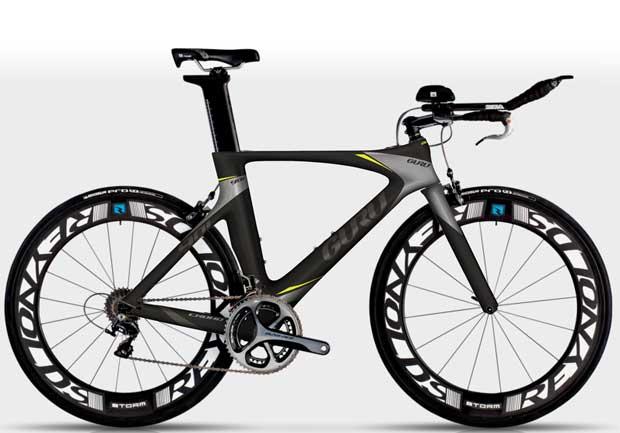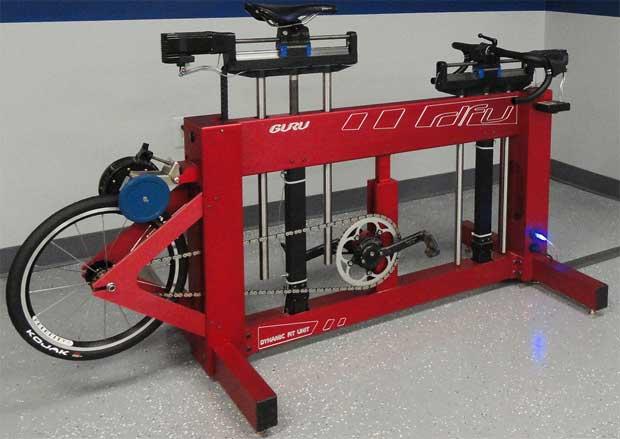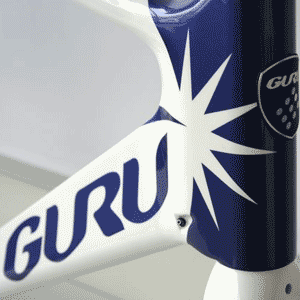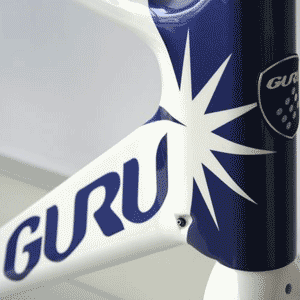The Death of Guru
This Canadian bike brand filed for bankruptcy on the 21st of December, 2015. According to one source inside the company, this isn't a Chapter 11 type of bankruptcy. That is, it's not an attempt to reorganize and rise like a Phoenix. This is, according to my source, “indeed the end of Guru.”
I have some observations to make.
I visited this company in 2005. Even back then it was doing something remarkable by building custom frames out of all four frame materials: steel, aluminum, titanium and carbon. It did it all in 6-thousand feet of space, which also included a state of the art paint booth imported from Italy. This tight Montreal-based factory looked like Agent Q's MI5 workshop.
For my visit I brought with me a collapsible version of a fit bike. What I said to these guys was, “You think your competitor is Cervelo, because you're both Canadian and you each sell to triathletes. Your true competitor is Serotta, because you each make custom bikes.”
Just like Rocky's manager Mickey, who insisted that the missing ingredient was the manager, I told GURU that its missing ingredient was a system. Serotta had a system. A system and a tool. A pathway from customer-walks-in to customer-individualized-geometry. This kind of prescriptive selling is powerful, and GURU's management, to its credit, incorporated the idea.
I exhorted GURU to build its own fit bike. I showed them what I felt were the basic functions. Three years later they debuted their own. It was in my view over-ambitious, that is, it was terrific, but more than what they needed. The GURU DFU was a motorized bike, computer controlled, software driven, and obeyed a basic principle of adjustment along an X/Y axis both in front (handlebars) and rear (saddle).

This was just what the doctor ordered, but a process for using the fit bike was still largely up to the fitter to divine for himself. The basic functions of the bike were known, but a fit protocol was not codified. (In fact, we only just last week finally published the industry's first brand-agnostic manual for the general use of these kinds of fit bikes.)
Further, there was a limit to the number of these bikes GURU produced. These so-called legacy bikes numbered about 47. Certainly GURU needed a wider buy-in at the dealer level. These fit bikes were a huge drain on the resources of the company. While the bike was revolutionary, the monumental cost to develop, build, sell and maintain this marvelous piece of technology was out of scale with the economics of the company.
In 2009, shortly after the time the DFU was unveiled, GURU was close to insolvent. A businessman not from the industry, Ted Matthews, bought assets encumbered by GURU's bank, becoming the brand's new owner. According to my recollection of events at that time, Matthews gifted a stake in the ownership of his new company back to the key employees who had previously founded the company, as an inducement to keep them aboard.
In 2011 Dorel Corporation – owners of Cannondale, Schwinn, and other bike brands – made the strategic decision to aggregate the best brands in each category of bike fit, put them together, and produce the best fit and prescriptive solution available. This meant the GURU fit bike paired with our own F.I.S.T. protocol for bike fitting. We agreed to license the use of F.I.S.T. to GURU, to write its initial documentation, and to instruct its instructors, and Dorel purchased the name GURU and all rights and patents to the fit bike, licensing the use of the name back to the Montreal-based custom bike factory.
This gave GURU (the bike maker) a needed cash infusion, but there was an insidious side to the fit tool it designed. Two things in the bike industry were changing. First, these new prescriptive systems like F.I.S.T. and Retül were both ecumenical and designed around the prescribing of production bike solutions. These kinds of fit bikes, GURU's inclusive, were fabulous tools not just for generating a great position for the rider, but for prescribing complete bike solutions that included production bikes, rather than simply custom geometries.

Second, systems like these routinely produced solutions that called for geometries not made by production companies. Trek's Madones, made in its H1 geometry, were simply too long-and-low to be of use to the majority of Trek's customers. These new fit systems exposed the glaring omissions in the product lines of bike brands that custom bike makers exploited.
In response, Trek produced a more moderate H2 geometry. It also produced a women's geometry only to eventually discover that it wasn't just for women, it was a great geometry in its own right. Its H3 geometries are now a staple in its line, all the way up and down the size chart.
These “grand fondo” geometries are now made by most mid-size and large producers of road bikes. Giant's Defy, the Specialized Roubaix, and Cannondale's Synapse, are just a few examples. With these prescriptive fit systems, and bikes now available along the gradient of long-and-low to narrow-and-tall, the urgency for custom bikes was not as ardent as it once was. Who, then, needs a custom bike, when production geometries like these are ubiquitous?
The explosion of new production bike geometries was not the only new hurdle GURU faced. The second was the wane in interest in welded bikes. Titanium, steel and aluminum bikes gave way to molded carbon bikes. To be sure, GURU made a crackerjack carbon bike that was droolworthy and entirely custom. Just, in triathlon, the move was toward the superbike – carbon bikes with integrated aerobars, forks, brakes, stems – in those price categories in which GURU participated. It's very hard to make a custom superbike.
Does this mean the brand is dead? In my opinion, yes. Dorel's (Cannondale's) use of the GURU name has always been a little confusing. Is Dorel interested in relicensing to an entity rising from the bankruptcy ashes? I don't know, but I would wager not. Dorel finally has a clean and clear brand name for its fit system. I doubt it will give that up.
Does this mean the product is dead? No. there are molds, fixtures, tools, welding machines, out-of-work welders, inventories of raw materials, and I can imagine somebody buying it all at a discount from the largest secured creditor (the bank) just as happened back in 2009. If so, a new custom bike maker would be up-and-running, on the cheap, just probably under a new brand.
There have always been 2 justifications for a custom bike: because it's needed; and because it's wanted. The second justification is just as appropriate as the first. There will always be custom bike makers.



